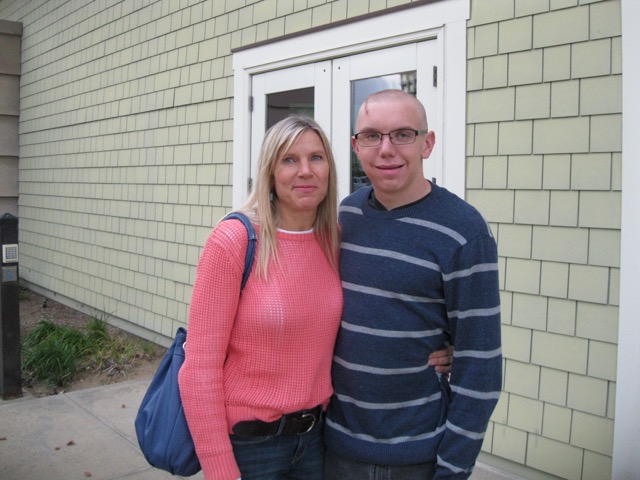City Council Meeting, January 19, 2016
Mayor Casey Tanaka pledged to support making cul-de-sacs on A, B and C Avenues between Third and Fourth Street where they touch Third Street in an effort to make those streets safer. He made the announcement at the January 19 city council meeting following impassioned pleas by two mothers – Kim Schmid and Quelene Slattery — whose sons were seriously injured in the corridor leading to the Coronado Bridge.
Schmid’s 19-year-old son Joshua was hit by a car last Wednesday evening while was hauling trash cans across the street. This past summer a 70 year-old man was killed at the same location.
The college freshman suffered an epidural hematoma, basically a bleeding artery in the brain, “that would have killed him without surgery,” his mother Kim Schmid said.

With a shaved head and a scar etched into his skull, Joshua spoke during oral communications. He apologized for his “bad hair day,” then asked the city council to “encourage people to drive slowly and drive carefully. I don’t want to see another accident on Fourth Street.”
Quelene Slattery, whose son Frankie was hit in the same corridor in April 2014, demanded the council to do more than encourage people to be careful. “It’s time to do something about it,” she said. “Implement that plan that we spent $50 thousand on.”
Taking aim at Tanaka, who voted against installing traffic lights on Third and Fourth last fall Slattery said: “You’re a history teacher and you’re going to sit there and tell professionals that have done this for years, educated professionals in civil engineering that you, a history teacher, just doesn’t think this would work.”
Since her son’s accident Slattery has campaigned tirelessly for traffic lights and other measures to slow traffic in the corridor. She and her husband are also suing the City of Coronado for $15 million to compensate for their son’s injuries.
Kim Schmid called for a more comprehensive approach. “We need to change the freeway mentality of this one way street and create two-way streets, put cross walks or street lights at every corner, bring the street limit down to 25, anything, everything. Make Third and Fourth Streets village streets like you all get to enjoy,” she said.
Tanaka replied by a offering an apology to Joshua on behalf of the city and then reiterated his opposition to traffic signals. “I don’t believe traffic lights are going to change safety in Coronado,” he said. “I do believe that they are going to make our streets less efficient [and that] they will spread unsafe conditions to other intersections.”
Instead Tanaka addressed what he sees at the heart of the matter, “people who want to make a left turn on Fourth and in many cases people who cross three lanes of traffic to make a right-hand turn.”
“If those streets and alleys are closed off, one continuous sidewalk can go in from A Avenue to Orange Avenue on the left hand side of Third Street and people trying to cut across town using those streets would be permanently preempted from such a maneuver,” Tanaka said in an e-mail.
Councilman Richard Bailey was impressed with Tanaka’s idea. He said that believes it would be “more effective at reducing cross-through traffic than a proposal he made last summer to restrict left-turns on Third during certain hours,” and should be considered by the council when it takes up turn restrictions on February 19.
“I’m not advocating we abandon the initial review of turn restrictions… but I do believe cul de sacs are another alternative that should be strongly considered,” Bailey said in an e-mail.
Either would require voter approval, but there are two routes to that approval. One initiated by the city council, the other by residents.
Both require the signatures of 620 registered voters and must meet a July deadline to qualify for the November 2016 ballot. Otherwise proponents would have to wait for the next general election in 2016 or hold a special election, which would be costly.
Bailey advocates pursuing both citizen and council supported initiatives for one simple reason. “Prior to seeking voter approval, the city would have to go through an environmental review process which would be lengthy and may delay any proposal getting on the ballot, a citizens’ initiative would not,” Bailey said.
Other Actions:
Gave the staff direction on crafting a memorial policy for the city that includes: asking people to cover the cost of installing, maintaining and sun setting benches or plaques. It also asked the staff to provide a rudimentary inventory on how much space is left for memorials.
Sent a proposed fee schedule for inclusion on the Memorial Wall at the John D. Spreckels Center back to Parks and Recreation Commission to discuss acknowledging in-kind gifts and an allowance for higher levels of donation, should they occur.
Ratified a processional services agreement with Kelly Purvis to serve as the city’s arts administrator.
Authorized a grant application to fund a diversion program for bicycle infractions.
A vote on making commercial loading zones in the alley adjacent the El Cordova Hotel and the Oxford Park Complex permanent was continued until March 19.





